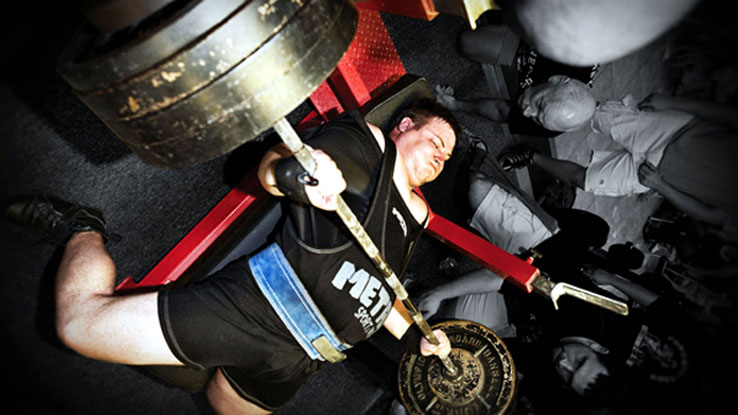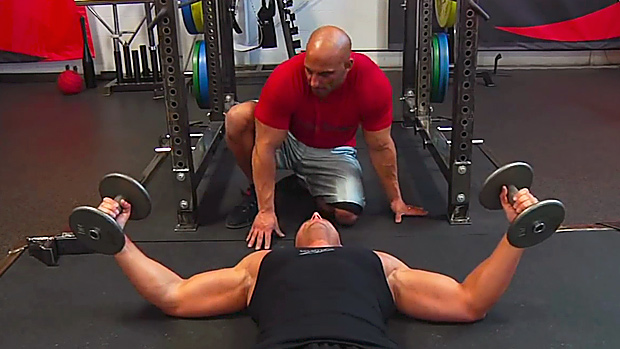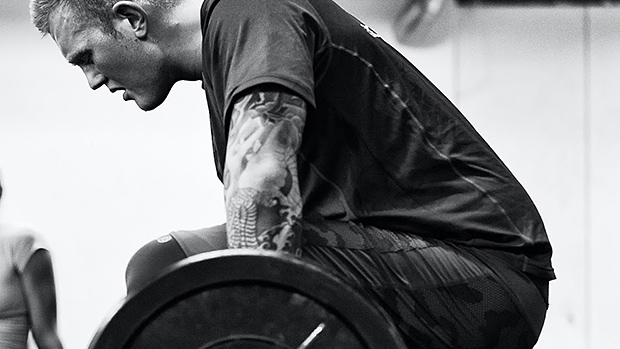In part 1 of this article, Dave Tate talked about his passion for lifting, the final word on what training does for him, the importance of progressive overload, and explosiveness. There's a lot more here in part 2.
What's the final word on preventing or dealing with injuries?
Simple. Don't train.
Okay, that was a jerk answer but it's also the truth. If you just want to look good for the beach and be stronger than the average guy there's absolutely no reason to get injured, unless you're a complete moron.
Learn good technique from day one, follow a decent program, and stop every set 1-2 reps shy of failure. Let your diet do the rest of the work and reap the rewards.
But if you want to be exceptional – like really freaking strong or really big – you're going to have to step it up and expose your body to greater risk of injury.
You can get far training safe but there's a limit. I don't care what anyone says, you will not reach your full potential in anything without pushing the envelope.
I'm not proud of the laundry list of injuries I've suffered, but I don't regret the motivation behind why I suffered them. I was trying to be the strongest motherfucker on the planet, not impress some clown at the gym or my own ego.
Still, I'm reminded of the choices I made every day when I can't reach my hand over my head.
So if you're an ordinary guy and don't want to end up like, well, me, what should you do?
First, start putting your compound lifts last (unless you are a competitive powerlifter, but that's a completely different topic).
Your performance in the big lifts will suffer – though likely not as much as you think – but you'll go a long way towards preventing the typical barbell injuries. Besides, if you're a bodybuilder, why are your big 3 so important to you anyway?
Next, take your warm-up sets seriously. Most guys warm-up sufficiently for the bench or squat, but they do the following for smaller movements like curls:
Let's assume an 8RM of 50 pounds and the workout calls for 3 sets of 8 reps.
- 30 pounds x a couple reps (warm-up)
- 40 pounds x 8
- 45 pounds x 8
- 50 pounds x 8
A smarter way, one that I learned from John Meadows, would be:
- 35 pounds x 8
- 45 pounds x 8
- 50 pounds x 8
- 50 pounds x 8
- 50 pounds x 8 (all sets with 50 pounds, stopping just shy of failure)
Of course, you might only get 8 reps with 50 pounds the first work set, but that's still double the quality volume. And in bodybuilding, volume with a meaningful load is crucial.
However, if you're a beat-up former or current powerlifter, I suggest trying what I did in this installment– doing full range of motion exercises with slow tempos and workable loads. It sucks and is boring as hell, but it worked better for me than all the mobility drills put together.
Biggest mental lesson from Westside?

To rise above the bullshit. To be a team first and get shit done. If you couldn't see past the drama or your own reflection, you were in the wrong place and wouldn't last.
This explains why in the 10 years I trained at Westside I saw very few people get kicked out, but did see many people leave and never come back.
It boils down to keeping ego in check. A lot of gyms miss out on being truly great strength places because ego gets too much oxygen. When that's allowed to occur, someone invariably thinks they're interests are bigger than the rest of the club.
So they go off on their own and set up camp somewhere else, usually a gym where they're the top lifter by a country mile and have a bunch of ass-kissers around to remind them of how strong they are.
Sure, it's comfortable – they don't have other strong guys constantly nipping at their heels or Louie in their face telling them to get their act together.
But when you're Grand Poobah, what do you learn lifting with a bunch of people that are weaker than you? How can you grow? You basically cut your progress off at the knees, all because you wanted to be Mr. Big Shit. No wonder Louie wouldn't have any of it.
The next lesson, and this is related to the first, is that to be truly excellent, you have to make helping others become better than you your number one goal.
A lot of guys, even some of the guys at Westside, never truly bought into this. They'd pitch in and assist and give spots or whatever, but they never really relished in seeing someone else excel. And that should be goal number one.
Today I realize that's what greatness is built upon. It's like a circle – someone mentors you, you excel and mentor the next guy to be better than you, and the whole team wins.
It always stings a bit to see your name wiped off the board, but what some don't get is that your time to be number one may come again. If it doesn't, and you did your job, while you may not see your name when you look up at the board, you'll see all those you helped to get up there. And there should be pride in this.
What's the biggest technique issues you see among regular gym rats?
Squatting is an absolute train wreck. I don't want to get into it. Just read this article. Watch the videos. Learn to squat, and squat well.
Deadlifting is getting as bad squatting, unfortunately. My biggest peeve is all these clowns posting pics of their deadlift with bumper plates. I see these bars stacked right to the collars and think wow, that's an 800-pound fucking pull. Then I take a closer look and realize that it's stacked with 10-pound bumper plates.
Please, to deadlift in a manner befitting a proper deadlifting barbell, use steel plates. If you have to use bumpers, then use the fucking 45's.
And stop posting pics of that shit and calling it Beast Mode. It's more like Yeast Mode.
Many powerlifting assistance movements should be in a bodybuilder's repertoire. Any favorites?

That's a good question, and my eyes have really been opened to this since training with Meadows.
Now John is a smart guy and is keen about changing things up, but for shit sake man, there's more to triceps than extensions and pressdown variations. Granted, John also has 20-inch arms so he kind of knows what he's doing, but my point stands.
The powerlifting variations are way more effective in my opinion and far easier on the elbows than even "light" skullcrushers. They also carry over to the bench better.
For triceps, these are my favorite powerlifting movements:
- Floor press
- Pin press
- JM press
- Close-grip push-up
- Band pushdown
Incorporating powerlifting variations into a bodybuilding program could be the most effective step a struggling bodybuilder can take. It's also a huge can of worms, and deserves at least its own article – or more – so stay tuned.
What's the biggest thing you learned about nutrition through all this?
To put it simply, nutrition is way more important than I ever gave it credit for.
I ate a lot of crap when I was younger, but since I was trying to get as big and strong as possible, it never really held me back. However, when I eventually had to pay the piper and lose fat, my nutrition obviously had to improve.
Next, when I moved from just wanting to be healthy to looking jacked, nutrition suddenly became hugely important. And now, as I set out to live life looking like a bodybuilder and being healthy, nutrition accounts for about 80% of my efforts.
The biggest thing I've learned is that healthy food doesn't have to taste bad or be boring as hell, nor do you have to eat the same things every day (though I freely admit that I still do).
The next thing is how much of a difference peri-workout nutrition makes.
Back when I powerlifted competitively, we used to just eat a ton and usually drank some type of sugar like Gatorade around training. That seemed to "work" okay, though it's impossible to say with the other 8,000 calories I was cramming in every day.
Once I quit powerlifting seriously, I dropped the Gatorade and never really missed it, especially considering I don't enjoy drinking much fluid while training anyway.
So when Tim Patterson first asked me about trying his protocol I was extremely skeptical. I'm already not a fan of workout drinks, and now you want me to suck back a gallon of this stuff? (His original prototype was unflavored, imagine that.)
But I took him at his word and gave it a shot, and was completely blown away by the results. In fact, I contribute much of my recent success to BIOTEST's Plazma™. The stuff just flat out works. You get leaner almost daily while adding weight and strength. It's nuts.
If you don't believe me, ask Meadows. He's added 10 pounds of stage weight in one year and the only thing he changed in his prep was adding Plazma™ during his workouts. For someone at his level development, 10 pounds in one year is ridiculous.
The exact protocol that Tim sent me was 4 scoops of Anaconda™ Muscle Loading Protocol™ before training, 2 scoops of Plazma™ during the workout, and 2 scoops of Mag-10® Protein Pulsing Protocol™ post workout. That's it.
It's still a lot of liquid, but I feel like it buys me considerable leeway. I can basically screw up my diet everywhere else and as long as I take in this protocol, I'll meet my body's needs and grow.
That's a huge plus for me. I have enough to think about, so the last thing I want is to be stressed about what I eat. It's nice knowing that as long as I have these drinks around my training sessions that I can basically cruise through the rest of the day. So if anything, this peri-workout protocol is a huge stress reliever.
Again, it's not post-workout nutrition. Post workout is only part of the equation as you miss out on a huge opportunity by not having carbs and amino acids present in your bloodstream while lifting. That's when it really matters.
I especially like this protocol for guys who are either too busy to eat or don't have a big appetite. I personally find it very hard to eat even 4000 calories per day, and the truth is I'd rather not. So gaining weight is and has always been a struggle. So for me, peri–workout nutrition is a lifesaver.
What makes a good coach-client relationship?

Like any relationship, the number one thing is respect, and it has to go both ways. The coach has to be patient and overlook your immediate flaws to see the bigger picture and capable of figuring out what you need to excel long term.
And of course, the trainee has to accept that the coach is human and may not have all the right answers 100% of the time. This is something I see increasingly happening, especially in bodybuilding.
Guys hire a coach to get ready for a show, they work together for 12 or 16 weeks but things don't quite come together in time. So the trainee is disappointed, fires the coach, and hires someone else.
The thing is, everyone is unique, and it may take even the most astute coach a few months just to figure out how your body works, what foods make you hold water, how you respond to training and energy system work, and how well you recover.
I made my best progress strength-wise when I spent 10 years under the tutelage of Louie Simmons. 10 years is a long frickin' time, but I needed a year to buy into his system, and then at least another year for Louie to identify exactly what I needed to work on.
Sometimes I wonder just how strong I could've become had I headed to Westside right after high school when I was a 500-pound bencher but still relatively raw.
Physique-wise, I made great strides with John Berardi and Shelby Starnes and Justin Harris, but I never enjoyed the balance between health and body composition like I do now with John Meadows, and it's not because Meadows is any smarter than those other guys. He's just had over two years of watching my physique and tweaking my diet to figure out how my body works.
So find a competent coach who you enjoy working with, preferably a decent guy who won't abandon you when he gets busy. Then stick with him. Let him figure you out and approach this thing as a team.
However, I still need to rant: most coaches suck!
Look at some of the programs being pushed today. It's a travesty, and I honestly think it's gotten worse over the past five years.
It seems like many new coaches and trainers have zero interest in studying the science of training or in doing any research whatsoever. They don't teach the lifts properly – just watch some of their YouTube videos – nor do they know how to program them.
All they seem capable of doing is taking any successful program they can find and copying it (sometimes even selling it) without taking the time to even try to understand it.
I'll admit to being a bit of a technique whore, and I agree that you won't always see the best technique during a work set. And there's always the possibility of joint or structural limitations that make the lift look bad.
But that's not what I'm talking about. I'm not busting chops over coaches allowing partial reps, leaning forward in the squat, or slightly hitched deadlifts. I'm talking about things that would make anyone say what the fuck?!?
I'm not going to elaborate any further. There are still many great strength coaches out there doing a fine job, but to those who I am talking to – clean up your act and start respecting your craft, or get the hell out. You know who you are.
In bodybuilding, is it volume, intensity, or variety?

Great question. I'd say it's all three.
First, let me define intensity as that's often a point of confusion, especially for guys who have toes in both the strength world and the bodybuilding world.
I define intensity from the classic strength context, meaning as a percentage of 1RM, not simply as "working really hard," which is how most bodybuilders define it. But for our purposes, we'll use the bodybuilding definition.
For hypertrophy, you have to work hard and you have to work with enough volume. The heavier sets build strength and allow you to use bigger weights during the 6-12 rep hypertrophy sets. And most recreational bodybuilders fail on both fronts.
Intensity-wise, I like bodybuilders to work each set just shy of failure – 1 rep in the hole is a good guideline. There's no need to drag out sets until you blow your scrotum off, although I've noticed that my "one rep in the hole" is often another guy's balls-out killer set.
Expect more from yourself and raise the bar. If you're capable of sending a legible text message between sets, you probably aren't working hard enough.
Volume-wise, that's a little more individual. Some can definitely handle more, but it's often excessive volume that pushes recovery boundaries.
A good rule for hypertrophy is to train until you start to lose your pump and then end the session. Leave the gym feeling gassed, but not throwing up in the parking.
It boils down to common sense. Look at the bodybuilders winning shows – whether they're pros or amateurs or natural competitors – they all follow a basic template: 2-3 exercises per body part, 3-5 sets of 6-12 reps, each set taken just shy of failure, and each body part trained every 3-7 days.
That's basically what most of them do, so why reinvent the wheel?
What are the best intensity techniques, and how can you program them to avoid overtraining?

As stated, I like sets to generally stop just shy of failure, even if it's 4 or 5 sets. There's simply no physiological need to extend the set deep into the pain zone to elicit an adaptation. That's not just my opinion either, it's one that's supported in the literature and shared by strength coaches for decades.
However, I still do them on occasion. Meadows is a ridiculously hard trainer, and every workout has at least one strip-set or extended set that leaves me in a sweaty heap.
Keep in mind, John and I have both been training for nearly 30 years. There isn't much our muscles haven't been subjected to, and even basic, hard work sometimes isn't enough.
But for the younger trainee I wouldn't bother. It isn't necessary, and you can get everything you need by keeping the quality of your sets very high (good form), working reasonably hard (1 rep shy of failure), and getting in enough volume (don't count your warm-ups as work sets).
Another thing, most trainees don't rest enough between sets. You should rest at least 90-120 seconds between work sets to allow for maximum poundage to be used.
Sure, you can step it up somewhat between sets of curls or pressdowns, but if there are plates on the barbell, then give the set the proper respect it deserves. Rest as long as you need and then rest a bit more, and then hit your set.
It might result in your workout exceeding 60 minutes, but you won't suddenly evaporate if your session exceeds an hour. Not to mention, the peri-workout nutrition buys you some leeway, so take advantage of it.
Take every single set seriously. Pretend training is your job and substandard effort just won't be tolerated. Set high standards for your partners, and if anyone tries to hold you back, dump them.
And if you see you're holding yourself back, remember how important this is to you. There are no do-overs or mulligans in life. Get after it, today.
See you soon.
Dave Tate





